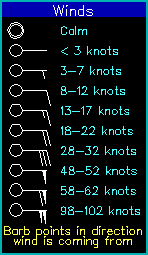
Today's News

Spring's Journey North

Report Your Sightings

Teacher's Manual

Search Journey North
|
Weather and Songbird Migration Primer by Ornithologist Dr. David Aborn How to read the weather from a songbirds's point of view. |
 |
Dear Students:
As I am sure you are aware, weather plays a very important role in bird migration. This spring, I will teach you
how to read a weather map to try to predict areas of the country that might see large numbers of migrants landing.
Let's start by looking at the general features of a weather map. The H's and L's represent high and low pressure centers, areas of swirling air.
- The air around a high pressure center circulates clockwise
- Whereas the air moves counter-clockwise around a low pressure system.
The colored lines represent fronts, dividing lines between cold and warm air.
- Blue lines represent cold fronts, with warm air in front (to the right of) the line and cold air behind (to the left) it. (Click for more information about cold fronts by U. of Illinois or USA Today.)
- The red line is a warm front, with colder air in front of it and warm air behind. (Click for more information about warm fronts by U. of Illinois or USA Today.)
So what does this all mean for birds?
Watch the High Pressure Systems
Birds want to fly with a tailwind to help them travel farther. In the spring, this means winds moving south to north. Headwinds, wind moving north to south (in spring), make it too difficult for birds to fly, so they are forced to land. Bad weather, such as heavy rain, also forces birds to land.
Since highs follow cold fronts, birds will be force to land immediately following the
passage of a cold front. After the high has moved east, usually a day or two later, the birds have tailwinds and
take off.
|
|
Winds Associated With High Pressure
|
|
High Pressure Flags show direction wind is blowing from. (Click on face of map to enlarge.) |
|
So why don't birds use low pressure systems?
The reason is that low pressure systems often bring bad weather with them, so even though the winds may be right,
flying conditions are not good.
Is Today a Good Day for Migration?
Check out the Current Surface Map and test
your skills. Find the high pressure systems and look at the wind direction.
Until next week,
Dr. David A. Aborn
david_aborn@baylor.edu
See USA Today's Amazing Weather Graphics!
These weather concepts can be very difficult to visualize. The following illustrations help to simplify a complicated topic:







